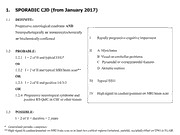
Preview criteria 0
1. SPORADIC CJD (from January 2017) 1.1 DEFINITE: Progressive neurological syndrome AND Neuropathologically or immunocytochemically I Rapidly progressive cognitive impairment or biochemically confirmed II A Myoclonus 1.2 PROBABLE: B Visual or cerebellar problems 1.2.1 I + 2 of II and typical EEG* C Pyramidal or extrapyramidal features OR D Akinetic mutism 1.2.2 I + 2 of II and typical MRI brain scan** OR III Typical EEG 1.2.3 I + 2 of II and positive 14-3-3 OR IV High signal in caudate/putamen on MRI brain scan 1.2.4 Progressive neurological syndrome and positive RT-QuIC in CSF or other tissues 1.3 POSSIBLE: I + 2 of II + duration < 2 years * Generalised periodic complexes ** High signal in caudate/putamen on MRI brain scan or at least two cortical regions (temporal, parietal, occipital) either on DWI or FLAIR 2. ACCIDENTALLY TRANSMITTED TSE RELEVANT EXPOSURE RISKS FOR 2.1 DEFINITE THE CLASSIFICATION AS IATROGENIC CJD Definite CJD with a recognised iatrogenic risk The relevance of any exposure to disease factor (see box) causation must take into account the timing of the exposure in relation to disease onset 2.2 PROBABLE • Treatment with human pituitary growth 2.2.1 Progressive predominant cerebellar hormone, human pituitary gonadotrophin or human dura mater graft. syndrome in human pituitary • Corneal graft in which the corneal donor hormone recipients has been classified as definite or probable human prion disease. 2.2.2 Probable CJD with recognised • Exposure to neurosurgical instruments iatrogenic risk factor (see box) previously used in a case of definite or probable human prion disease. 2.3 POSSIBLE This list is provisional as previously Possible CJD with a recognised risk factor unrecognised mechanisms of human prion (agreed and EURO meeting Bled, 2006) disease may occur 3. GENETIC TSE •PRNP MUTATIONS ASSOCIATED WITH GSS NEUROPATHOLOGICAL PHENOTYPE 3.1 DEFINITE P102L, P105L, A117V, G131V, F198S, D202N, Q212P, Q217R, M232T, 192 bpi •PRNP MUTATIONS ASSOCIATED WITH 3.1.1 Definite TSE + definite or probable CJD NEUROPATHOLOGICAL TSE in 1st degree relative PHENOTYPE D178N-129V, V180I, V180I+M232R, T183A, T188A, E196K, E200K, V203I, R208H, V210I, E211Q, M232R, 96 bpi, 120 bpi, 144 3.1.2 Definite TSE with a pathogenic bpi, 168 bpi, 48 bpdel PRNP mutation (see box) •PRNP MUTATIONS ASSOCIATED WITH FFI NEUROPATHOLOGICAL PHENOTYPE D178N-129M 3.2 PROBABLE •PRNP MUTATION ASSOCIATED WITH VASCULAR PRP AMYLOID Y145s 3.2.1 Progressive neuropsychiatric •PRNP MUTATIONS ASSOCIATED WITH disorder + definite or probable TSE PROVEN BUT UNCLASSIFIED PRION in 1st degree relative DISEASE H187R, 216 bpi, 3.2.2 Progressive neuropsychiatric •MUTATIONS ASSOCIATED WITH disorder + pathogenic PRNP NEURO-PSYCHIATRIC DISORDER BUT mutation (see box) NOT PROVEN PRION DISEASE I138M, G142S, Q160S, T188K, M232R, 24 bpi, 48 bpi, 48 bpi + nucleotide substitution in other octapeptides (additional list of mutations appended) I A Progressive neuropsychiatric disorder 4. vCJD B Duration of illness > 6 months C Routine invesitgations do not suggest an alternative diagnosis D No history of potential iatrogenic exposure 4.1 DEFINITE E No evidence of a familial form of TSE II A Early psychiatric symptomsa 1A and neuropathological B Persistent painful sensory symptomsb confirmation of vCJDe. C Ataxia D Myoclonus or chorea or dystonia E Dementia 4.2 PROBABLE III A EEG does not show the typical appearance 4.2.1 I and 4/5 of II and IIIA of sporadic CJDc in the early stages of illness and IIIB B Bilateral pulvinar high signal on MRI scan 4.2.2 I and IV Ad IV A Positive tonsil biopsyd a depression, anxiety, apathy, withdrawal, delusions. 4.3 POSSIBLE b this includes both frank pain and/or dysaesthesia. c the typical appearance of the EEG in sporadic CJD consists of generalised triphasic periodic complexes at approximately one I and 4/5 of II and III A per second. These may occasionally be seen in the late stages of variant CJD. d tonsil biopsy is not recommended routinely, nor in cases with EEG appearances typical of sporadic CJD, but may be useful in suspect cases in which the clinical features are compatible with vCJD and MRI does not show bilateral pulvinar high signal. e spongiform change and extensive PrP deposition with florid plaques throughout the cerebrum and cerebellum. ADDITIONAL LIST OF MUTATIONS • PRNP MUTATIONS WITHOUT CLINICAL AND NEUROPATHOLOGICAL DATA T188R, P238S • PRNP POLYMORPHISMS WITH ESTABLISHED INFLUENCE ON PHENOTYPE M129V • PRNP POLYMORPHISMS WITH SUGGESTED INFLUENCE ON PHENOTYPE N171S, E219K, 24 bp deletion • PRNP POLYMORPHISMS WITHOUT ESTABLISHED INFLUENCE ON PHENOTYPE P68P, A117A, G124G, V161V, N173N, H177H, T188T, D202D, Q212Q, R228R, S230S
